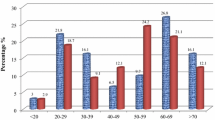Abstract
Inguinal hernia repair is a common procedure in general surgery today, and an ideal operation to treat inguinal hernia is still far to define. The synthetic prostheses commonly used in its repair can create a few clinical problems which have influenced many investigators to look for new hernia repair techniques, and an example of such efforts is Desarda’s method of inguinal hernia repair. The objective of this study was to clinically evaluate the technique of Desarda’s repair for inguinal hernia on parameters such as technical feasibility, post-operative pain, incidence of complications in terms of wound morbidity (seroma, surgical site infection, persistent pain), testicular atrophy, and recurrence rates. Among 30 patients selected, Desarda’s technique for inguinal hernia repair was evaluated, and outcome was measured in terms of post-operative pain, surgical site infection, seroma, testicular atrophy, and recurrence at 4 weeks, 6 months, 1 year, 2 years, and 5 years. In this prospective study over a period of 5 years, operating time observed was 49.60 ± 13.45 min; mean pain score observed using visual analogue scale (0–10) at 24 h was 2.4 ± 0.86. Complications noted were minimal, and most common complication noted was scrotal edema; none of the patients had recurrence or any long-term morbidity. Desarda’s technique of biological repair is a logical alternative considering the drawbacks of the use of mesh having shorter operative period, no chronic groin pain, minimal complications with no recurrence, and also being cost-effective.




Similar content being viewed by others
References
Awad SS, Fagan SP (2004) Current approaches to inguinal hernia repair. Am J Surg 188:9–16
Lau WY (2002) History of treatment of groin hernia. World J Surg 26:748–759
Natarajan B, Burjonrappa SC, Cemaj S, Fitzgibbons RJJ (2013) Basic features of groin hernia and its repair. In: Yeo CJ, Matthews JB, Mcfadden DW, Pemberton JH, Peters JH (eds) Shackelford surgery of the alimentary tract, 7th edn. Elsevier, Philadelphia, pp 556–582
Pardhan A, Mazahir S, Alvi AR, Murtaza G (2013) Surgical site infection following hernia repair in the day care setting of a developing country: a retrospective review. J Pak Med Assoc 63:760–762
Gopal SV, Warrier A (2013) Recurrence after groin hernia repair-revisited. Int J Surg 11:374–377
Amid PK (2004) Radiologic images of meshoma: a new phenomenon causing chronic pain after prosthetic repair of abdominal wall hernias. Arch Surg 139:1297–1298
Ridgway PF, Shah J, Darzi AW (2002) Male genital tract injuries after contemporary inguinal hernia repair. BJU Int 90:272–276
Szopinski J, Kapala A, Prywinski S (2005) Desarda technique for inguinal hernia treatment: first polish experiences. Pol Przegl Chir 77:159–168
Mitura K, Romańczuk M (2008) Comparison between two methods of inguinal hernia surgery--Lichtenstein and Desarda. Polski merkuriusz lekarski: organ Polskiego Towarzystwa Lekarskiego 24:392–395
Manyilirah W, Kijjambu S, Upoki A, Kiryabwire J (2012) Comparison of non-mesh (Desarda) and mesh (Lichtenstein) methods for inguinal hernia repair among black African patients: a short-term double-blind RCT. Hernia. 16:133–144
Desada MP (2001) Inguinal herniorrhaphy with an undetached strip of external oblique aponeurosis: a new approach used in 400 patients. Eur J Surg 167:443–448
Callessen T, Beck K, Kehlet H (1999) A prospective study of chronic pain after groin hernia repair. Br.J.Surg 86:1528–1531
Taylor SG, O’Dwyer PJ (1999) Chronic groin sepsis following tension-free inguinal hernioplasty. Br J Surg 86:562–565
McArthur LL (1901) Autoplastic suture in hernia and other diastases. JAMA 37:1162–1165
Ravitch MM, Hitzrot JM 2nd (1960) The operations for inguinal hernia. I. Bassini, Halsted, Andrews, Ferguson. Surgery 48:439–466
Desada MP (2003) Surgical physiology of inguinal hernia repair – a study of 200 cases. Bio Med Central Surgery 3:1–7
Author information
Authors and Affiliations
Corresponding author
Ethics declarations
Conflict of Interest
The authors declare that they have no conflict of interest.
Presentation Details
None.
Additional information
Publisher’s Note
Springer Nature remains neutral with regard to jurisdictional claims in published maps and institutional affiliations.
Rights and permissions
About this article
Cite this article
Sharma, H., Garg, P., Marwah, S. et al. Clinical Evaluation of Desarda’s Repair for Inguinal Hernia. Indian J Surg 83, 495–499 (2021). https://doi.org/10.1007/s12262-020-02382-w
Received:
Accepted:
Published:
Issue Date:
DOI: https://doi.org/10.1007/s12262-020-02382-w




